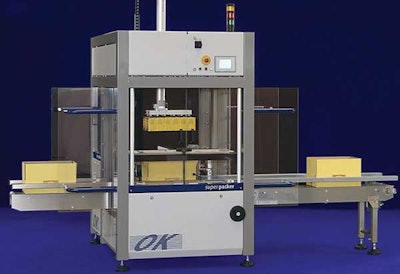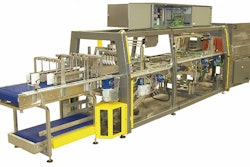
Initially introduced at Pack Expo Las Vegas ’03, an upgraded Superpacker from O/K Intl.. offers beefier motors, an enhanced human/machine interface, and smoother, faster case loading.
The upgrades rely on technology from Rockwell Automation that replaces the controls package the machinery builder had used before. At the heart of the improvements is an Allen-Bradley ControlLogix® 5000 integrated motion-controller/programmable logic controller.
The case loader has two servomotors for pick-and-place loading on two axes. Despite the more sophisticated operations, the new design is simplified versus other two-axis systems, according to O/K engineering manager Owen Kellett Jr. The two stationary Allen-Bradley MP-Series low-inertia brushless servomotors, run by an A-B Ultra3000™ servodrive, are linked directly together for vertical lifting by a single belt loop.
“That requires a fairly sophisticated algorithm, and it was one of the main reasons we went to the Allen-Bradley controller,” says Kellett. “The latest series of ControlLogix processors allows us to achieve the computational speed for the two motors along one axis. It permits powerful, one-step, coordinated motion commands.”
Side-to-side acceleration is minimized, which means quicker and smoother pick-and-place movements, Kellett explains. He says that coordinated motion reduces the forces on the product being loaded. Kellett feels that’s even more critical than the improved precision via the motor’s high-resolution encoder, along the order of 1/1ꯠ’’ rather than 5/1ꯠ’’ accuracy as before. Other highlights include the following:
• Faster speeds—about 20% to 25% faster, from 12 cycles/min to at least 15 cycles/min.
• Payload capability doubled—can handle 100-lb loads rather than 50 lb as before; the two servomotors were increased from 2 kW to 5 kW output.
• Improved communications—done internally on the Superpacker via SERCOS (Serial Real-time Communications Standard); it also has an Ethernet connection.
• Higher-resolution, larger touchscreen—A-B PanelView Plus™ human-machine interface.
“SERCOS simplified wiring considerably and simplifies troubleshooting,” Kellett says. With SERCOS, the packer can easily accept new devices, up to six more with the current setup and even more with a card change, Kellett notes. The PLC and Ultra3000 drives communicate via fiber optic cable, which, unlike standard wiring, is immune from electrical noise interference, he points out.
In replacing a 51?2’’-diagonal display, the HMI’s 7” high-resolution color monitor displays more than a prettier picture. It also plays a key role in troubleshooting. “We provide pictures for diagnostics that should make it easier for operators to diagnose a problem,” says Kellett. “The operator can see a picture of that machine section, so it’s a better, more visual indication of where the problem may lie.” He also says many more parameters are monitored, again a plus for diagnostics. Also, importantly, “the HMI makes programming easier.”
At press time, the first of the new-generation Superpackers was in the shop undergoing final preparations for shipment to the first customer, a paper products company.






















